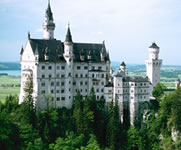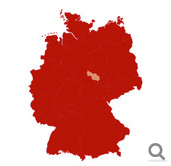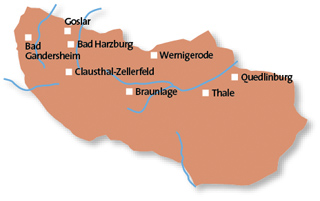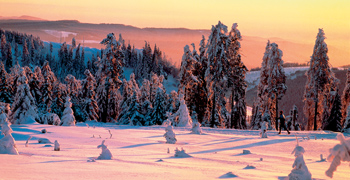
Historical Towns
- Historical towns in Brandenburg
- Cathedral Towns and Cities in Saxony-Anhalt
- The innovative Anhalt-Wittenberg Region
- Enchanting towns in the Harz
- The beautiful towns and cities in Saxony
- Towns and cities of culture in Thuringia
- Beautiful towns of Franconia
- East Bavarian traditional towns
- Alpine towns in the Allg�u
- The eastern Akpine Foothills and their towns
- Towns and villages in the western foothills of the Alps
- Mediterranean towns on Lake Constance
- Towns in the Swabian Alb
- Unspoilt towns in the Black Forest
- Towns for refined tastes in the Heilbronner Land
- Towns in the Odenwald
- Wine towns in Rheinhessen
- Saarland, a region of contrasts
- Romantic towns in the Hunsr�ck and Nahe Regions
- Idyllic towns and villages in the Moselle Region
- The Ahr Rhine Eifel holiday region
- Wine towns on the Romantic Rhine
- Modern towns and cities in the Bergisches Land Region
- The Lahn Valley and its fairytale towns
- Historical towns in Kurhessisches Bergland
- Sauerland's scenic towns
- Fairytale towns in the Weserbergland Hills
- Majestic towns in the M�nsterland Region
- The nine stars of Lower Saxony
- North and East Frisian Islands
- Vibrant Schleswig-Holstein
- Maritime towns along Mecklenburg's Baltic Coast
- Historical Hanseatic Towns
- Germany's Baltic Sea Islands
- The Mecklenburg Lakes
Contact and information
Mystical and unspoilt. The witches' dance on Mount Brocken

The Harz and its many facets
There are many sides to the Harz: gentle hills in the south, rugged rock faces and dramatic valleys in the north. In the upper Harz, the silver mining industry left behind many hollows and craters that have been filled in with water to create lakes. These and the flower-filled mountain pastures create an almost Alpine landscape. The Harz National Park is extremely diverse: dark forests, mysterious moors and clear streams penetrate craggy cliffs. For decades this former border zone between the two Germanies was left almost untouched and became a habitat for many endangered species. A lynx reintroduction project was launched ten years ago.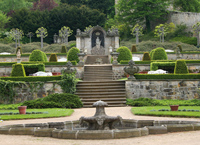
Quedlinburg
Quedlinburg, on the north-east edge of the Harz, became a UNESCO World Heritage site soon after German reunification. The entire old quarter with 1,300 timberframed buildings spanning six centuries has been accorded UNESCO protection. The town may be small, with winding lanes and medieval streets, but its citizens have preserved a great architectural legacy over the years. Highlights are the Renaissance town hall, the castle, the Romanesque collegiate church with the cathedral treasury and the Romanesque Church of St. Wiperti. A few miles to the west is Wernigerode, another town with great charm, its centre again characterised by beautifully restored half-timbered buildings. From Wernigerode you can reach the summit of fabled Mount Brocken without breaking into a sweat: on the Harz historical railway, which has the longest unbroken narrow-gauge network in Germany and regularly runs old steam locomotives as well as vintage trains unforgettable fun for railway enthusiasts.The silver region
Silver mining has a long tradition in the Harz, thanks to abundant silver ore deposits. Many Harz towns owe their prosperity to mining, iron and steel, most notably the former free imperial and Hanseatic town of Goslar whose silver mines in Rammelsberg continued to operate until 1988. Rammelsberg is now a visitor mine and UNESCO World Heritage site. The Upper Harz Mining Museum in Clausthal-Zellerfeld and the Wettelrode visitor mine also offer an impression of what it was like to work below ground.Walpurgis Night on Mount Brocken
On the night before 1 May the witches of the Harz emerge from their lairs to chase winter away. Walpurgis Night is celebrated in many towns in the Harz region. Bonfires are lit and people even without magical powers gather together for the dance. This ancient custom is pagan in origin, so when Christianity was being introduced, the Church attempted to ban it and anyone found celebrating was denounced as a witch. The tradition of dressing up as witches on Walpurgis Night continues in the Harz to this day.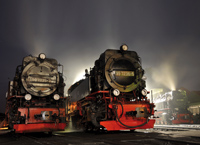
Activity holidays in the Harz
The Harz is an ideal destination for holidaymakers with energy to burn. In the summer you can enjoy long walks on the 94km Harz Witches' Trail or go mountain biking in the Harz Volksbank Arena. But it's in winter that the Harz really comes into its own. There are all kinds of winter sports to enjoy with snow-sure terrain into March.Cheese from the Harz
In contrast to Harzer cheese (Harzer Käse), which is available all over Germany, Harz cheese (Harzkäse) is a regional speciality. The two are quite different: Harz cheese is made with fresh whole milk, Harzer cheese with curdled milk. Most Harz cheeses are produced by small-scale farmers, vary in taste and quality and are sold almost exclusively at markets and farm shops. Another rustic speciality and perhaps not the easiest to digest is a typical miner's meal of homemade wurst, cheese, dripping, and gherkins accompanied by a strong schnapps.Travel Planner
Select an option...
Romance and charm
Every year during the festive season, confectioners, glassblowers, woodcarvers, toymakers and many other craftspeople set up their stalls against the backdrop of medieval facades on Goslar's market square for the prettiest Christmas market in northern Germany.
Food and drink
The Harz Red mountain cattle have a long, thick, reddish-brown coat. For nine months of the year they graze in the lush forest meadows of the upper Harz and in winter they are fed with hay. The Klein-Tirol mountain farm has a breeding programme for these rare cows.
History and tradition
Lead, copper and silver ore the Harz region's natural resources make it one of the most important ore-mining areas in the Germanspeaking countries. The Upper Harz Mining Museum in Clausthal-Zellerfeld charts the history of silver mining.
Nature and scenery
The lynx is back in the Harz National Park. These beautiful big cats were successfully reintroduced in 2000 and now visitors can get up close to Pamina and Tamino in the lynx viewing enclosure on the Rabenklippe cliff near Bad Harzburg.




